Tree in Diagram not centered
As Alan suggested without the \node macro:
\documentclass{article}
\usepackage{tikz-qtree}
\usepackage{float}
\newfloat{diagram}{!ht}{grm}\floatname{diagram}{Diagram}
\usepackage[labelfont=bf]{caption}
\begin{document}
\begin{diagram}
\centering
\Tree [.Root
[.{Internal} Research Sales ]
[.{TU Berlin} Research ]
[.{Charite} Research Sales ]
[.{...} Research Sales ]]
\caption{A Purpose Graph with Multiple Relevant Utilizer Distinctions}
\label{dia:mixed_tree}
\end{diagram}
In contrast, using a clear distinction of purposes and utilizers, we end up with a much more well-structured
set of trees with less duplicates (as seen in diagrams \ref{dia:split_tree_purpose} and
\ref{dia:split_tree_utilizer}):
\bigskip
\begin{diagram}
\centering
\Tree [.Root
[.{Medical} Research Sales ]]
\caption{A Purpose Tree in a Model with Separate Purpose and Utilizer Trees}
\label{dia:split_tree_purpose}
\end{diagram}
\begin{diagram}
\centering
\Tree [.Root Internal
[.{Universities} {TU Berlin} Charite ]
[.Hospitals {Charite} ]]
\caption{A Utilizer Tree in a Model with Separate Purpose and Utilizer Trees}
\label{dia:split_tree_utilizer}
\end{diagram}
\end{document}

I do not know how diagram is defined. However, I'd like to advertize forest here, and recommend \centering instead of the center environment and not add \vspaces.
\documentclass{article}
\usepackage{forest}
\begin{document}
\newenvironment{diagram}[1][]{\begingroup\renewcommand{\figurename}{Diagram}%
\begin{figure}[#1]}{
\end{figure}\endgroup}
\begin{diagram}[!ht]
\centering
\begin{forest}
for tree={parent anchor=south}
[Root
[Internal
[Research]
[Sales]
]
[TU Berlin
[Research]
]
[Charite
[Research]
[Sales]
]
[\dots
[Research]
[Sales]
]
]
\end{forest}
\caption{A Purpose Graph with Multiple Relevant Utilizer Distinctions.}
\label{dia:mixed_tree}
\end{diagram}
In contrast, using a clear distinction of purposes and utilizers, we end up with
a much more well-structured set of trees with less duplicates (as seen in
diagrams \ref{dia:split_tree_purpose} and \ref{dia:split_tree_utilizer}).
\begin{diagram}[!ht]
\centering
\begin{forest}
for tree={parent anchor=south}
[Root
[Medical
[Research]
[Sales]
]
]
\end{forest}
\caption{A Purpose Tree in a Model with Separate Purpose and Utilizer Trees.}
\label{dia:split_tree_purpose}
\end{diagram}
\begin{diagram}[!ht]
\centering
\begin{forest}
for tree={parent anchor=south}
[Root
[Internal]
[Universities
[TU Berlin]
[Charite]
]
[Hospitals
[Charite]
]
]
\end{forest}
\caption{A Utilizer Tree in a Model with Separate Purpose and Utilizer Trees.}
\label{dia:split_tree_utilizer}
\end{diagram}
\end{document}

The above code is a so-called MWE, i.e. starts with \documentclass, ends with \end{document} and loads all necessary packages.